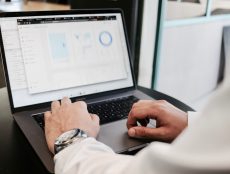
Education Technology
Op-Ed
Algorithmic Trading: What it is and How to Learn it
By eLearning Inside
May 17, 2022
Most traders or investors in the financial market dream of having a system that automatically trades for them without the need for them to do anything else trading related. While no such system truly exists, algorithmic trading comes very close.
Based on a recent market report, the global algorithmic market valued at $10.3 thousand in 2018 is anticipated to witness a CAGR of 10% over a forecast period (2022-2027). The demand for a fast, reliable, and profitable system is spearheading the growth of algorithmic trading.
However, despite the availability of various materials, a beginner with a non-technical background might find it very difficult to follow a systematic approach to learning algorithmic trading. There are some best ways to learn algorithmic trading, but before then, take a look at certain basic things you should know:
What is Algorithmic Trading?
Algorithmic trading, also known as automatic or Algo trading, involves using a computer to execute trades based on defined parameters automatically. Everything in Algo trading is data-driven, and you are free to do other things while your computer takes care of your orders.
Algo traders use a high-frequency technology to enable trading firms to execute large numbers of trades per second. However, despite being automated, automatic trading still involves some form of human intervention from time to time to ensure it is still working effectively.
The Difference Between Algorithmic Trading, Automated Trading, and Quantitative Trading
Most traders think that Algo trading, automated trading, and quantitative trading mean the same, but this is not true.
Automated trading, as the name implies, means everything is done automatically. It involves the use of a computer to create and execute orders automatically. In practice, it is simply automating the human manual trading process.
Algorithmic trading follows an algorithm to execute trades in line with some underlying trading strategy which can still operate manually with the human hand. Automated trading takes a step forward to automate the entire trading process.
On the other hand, quantitative trading, also known as quants trading or quants, involves using mathematical and statistical models and programming to analyze and execute orders.
One of the major differences between algo trading and quants trading is that quantitative trading uses a lot of data assets and mathematical models. In contrast, trading relies more on technical analysis.
How Profitable is Algorithmic Trading?
Unlike the traditional trading method, algorithmic trading reduces the time spent watching and analyzing the market, thereby allowing traders to focus on other aspects of their lives.
Trading algorithms account for 92% of Forex trades, and they can be very profitable if implemented with proper risk management and a good trading plan.
Getting Started with Algorithmic Trading
Many resources on learning algorithmic trading online might be difficult to digest. Still, if you take your learning process systematically, then no one can stop you from being successful at Algo trading.
Here are three steps any aspiring Algo-trader needs to focus on to learn algorithmic trading.
#1. Understanding the Core Areas of Algorithmic Trading
Algorithmic trading is multi-faceted. Hence, a proper understanding of the core areas is one of the first steps to creating a winning algorithm.
The core areas of algorithmic trading include:
Quantitative Analysis
Quantitative analysis(quants) involves identifying patterns and building models to access those patterns. The models generated are then used to predict the price movement of securities.
If you are a technical or fundamental-based trader, you may have to start thinking about quantitative analysis.
Financial Markets Knowledge
Naturally, the human mind is designed to learn by observation, and research has shown that spending time observing the chart will increase one’s knowledge of the financial market. This knowledge is crucial if you intend to build a technical-based algorithm.
Even if you are a pro in technical analysis, ensure you update your technical analysis skills from time to time. A thorough understanding of the following aspects will reduce your algorithmic trading learning curve.
- Types of trading instruments
- Trading strategies
- Proper risk management
- Pricing models.
Programming Skills
After learning the basics, the next step is to move to the more advanced aspect of algorithmic trading. If you have never compiled a code before, it’s time to learn Programming skills.
Most people consider this aspect the most difficult in learning algorithmic trading, but it’s not as complicated as you think. Whatever strategy you intend to automate, you will need a programmer to implement your trading strategy.
Sound knowledge of C++/Java/ Python is of necessity for a quant developer, and the best way to learn about programming is by practicing.
Amongst several programming languages, most traders prefer to use Python, and there are various tools and platforms for algorithmic trading that allow you to create your own trading algorithm.
#2. Becoming a Professional in Algo Trading
After understanding the core aspects of Algo trading, the next thing is to consider various ways to further increase your professional knowledge in this domain.
It is interesting to point out that you can also build a career in Algo trading.
Getting Started With Books
Certain aspects of algo trading require some degree of mathematical and statistical knowledge, which might be difficult for beginners to understand. Learning through books might not be for everyone, but algorithmic trading books present a straightforward approach to learning the concepts of automated trading.
While there are many good books on different algo trading strategies that you can look at, It is necessary to avoid complex mathematical concepts until the basics are understood.
For example, the “Options, Futures, and Derivatives” book by John C. Hull is considered a very good book for beginners.
Once you understand the basics, you can start developing your trading strategy, known as the alpha trading model. Algorithmic Trading by Ernest Chan and Trading and Exchanges by Larry Harris discuss trading systems and how to implement them.
Free Resources
In addition to the best books on Algo trading, you can also take advantage of various free resources available such as:
- Online webinars
- Youtube videos
- Following blogs on Algo trading, such as Experfy Insights blog, where you can learn anything about Algo trading.
- You can also take free courses on e-learning platforms like Udemy, Coursera, Udacity, and edX.
Although beginners can start with these free resources, it is pertinent to note that some of these resources have their shortcomings. For example, platforms like Udemy upload courses from 3rd parties which means their quality can vary. Check out this Udemy review for more.
For instance, algorithmic books might not give you first-hand trading experience, and free courses might offer limited knowledge on the subject matter.
Learn From Professionals
Learning from a professional or an expert practitioner is one of the fastest ways to learn any skill. Algo trading involves the use of programming languages like Python. Therefore It becomes necessary to learn from an expert so that you can interact with the expert while practicing their strategies alongside.
Go For MFE Programs
Most students who want to pursue research in the algo trading field go for MFE programs. However, If the goal is to make money, it becomes necessary to take a more career path by getting placed in the algorithmic trading domain.
Most MFE programs give an overview of mathematical concepts, and it is beneficial to learn from the experience of others when you decide to apply for their courses.
Additionally, MFE programs also give you various opportunities to apply for jobs even when you are still learning.
#3. Learn More and Practice on The Job
After getting placed in the algo trading domain, you can start implementing your knowledge on algo trading in live markets for your company. You can also learn other processes to add to your workflow chain since most firms use different approaches to automated trading.
For example, a low latent strategy trading firm might be built on C++, while another firm might only use Python. It becomes necessary to have an understanding of how both work.
In subtle words, keep learning and practicing on the job. Learning never stops.
The scope of Algo trading is unlimited.
However, learning algorithmic trading requires knowledge of the core trading areas and some degree of programming skills. It doesn’t have to be technical.
You can master this so-called “difficult” domain by following the right-learning process. Constant practice of what you’ve learned is necessary to gain mastery in the trading industry.
Featured Image:gorodenkoff, iStock.









No Comments